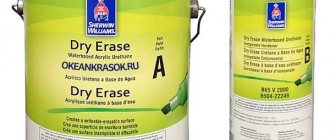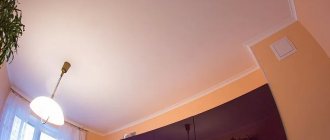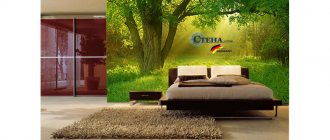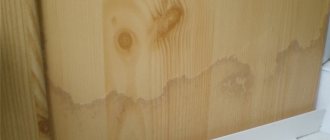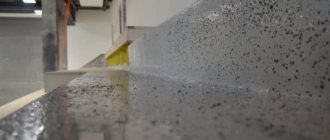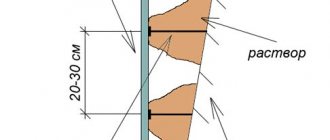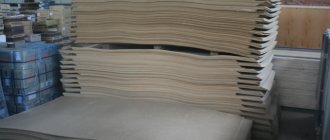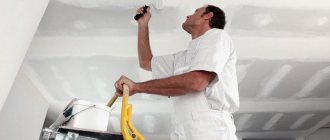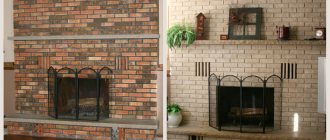Film wall finishing
In Soviet times, when the shortage of construction and finishing materials did not allow many owners to implement interesting creative ideas in furnishing their apartments, self-adhesive films were used instead of ceramic tiles in the bathroom. Of course, before even the choice of oilcloth for interior cladding work was not so large. We had to be content with what we could find on sale. Today everything has changed. Manufacturers offer many options for oilcloth “clothes” for walls to suit every taste and budget.
Of course, such material cannot be called high quality. When exposed to steam and water, the film quickly loses its original appearance. The colors on it are erased.
Nevertheless, if you follow all the technologies for gluing the surface, you can get a completely stable and reliable coating. The walls in the bathroom must be carefully prepared, old finishes removed, and primed.
Oilcloth for bathroom walls, photos of which and examples of design can be found on our website, is a canvas with a special waterproofing coating. This composition provides reliable protection of room walls from moisture. Sometimes the material is additionally sandwiched with foam rubber.
Advantages of film when finishing wet rooms
Bathroom film is far from the only cladding option. Panels, cork, wallpaper, tiles - all products are in demand and are suitable for finishing both bathrooms and other areas of the apartment. But despite high quality standards, the materials have one drawback - price! The cost of tiles is incomparable with the price of wallpaper, and they, in turn, are valued much higher than bathroom film. In addition, the speed of pasting surfaces is much faster, and the possibilities of the film are simply enormous! You need to turn an old cabinet into a decent piece of furniture or make a nice pattern on the doors - bath film will come in very handy.
- Affordable price.
- Large and varied range of colors.
- Fast process of facing work without the involvement of third parties.
- Easy to care for.
- Nice appearance.
Advantages and disadvantages of the material
This type of finishing has many advantages. One of them is easy installation. This type of lining can be changed quite quickly if the old oilcloth in the bathroom has become dilapidated.
This material is available in a wide range. Today you can buy films of any color, with different ornaments and patterns. This allows you to select finishes for any design and style of the bathroom.
Covering bathroom walls with oilcloth significantly saves the family budget. This is an inexpensive material that is not afraid of moisture. Consequently, dampness and mold will not appear in the bathroom.
This type of finishing can be used for other interior elements. For example, you can decorate the facades of an old cabinet or a section of the wall above the sink in the kitchen with self-adhesive film. In addition to its water-repellent properties, this material can withstand significant temperature changes.
They produce film without a backing, on a fabric or paper base, foamed or embossed.
At the same time, oilcloth for the bathroom, the design photos of which in our gallery will help you make the right choice, also has some disadvantages. Before covering the walls with polyvinyl chloride film, the facing surface must be perfectly smooth. Only in this case will the oilcloth lie flat and last a long time. It is necessary to remove all irregularities and defects in the coating and carefully plaster the wall.
In general, oilcloth finish is suitable for almost any substrate. It can be applied to glass, wood, plywood, metal, mirror, plaster surfaces and even tiles.
If you have chosen oilcloth for the bathroom walls as a finishing material, you should stock up on the necessary tools before carrying out the repair. You will need:
- special cutter for preparing film panels;
- pencil or ballpoint pen for marking;
- measuring tape or ruler;
- hair dryer (household or industrial); scissors;
- felt spatula or squeegee , which allows you to smooth out the facing material.
When applying self-adhesive film, a hairdryer is needed to treat surfaces, corners and joints with warm air. They also need to warm up the puncture sites of air bubbles that may appear during the installation of the oilcloth.
Preparatory work
Tool preparation
If you have already finally decided that oilcloth will be used as a finishing material for the walls in the kitchen, then for DIY repairs you will need the following set of tools:
- Cutter - it is necessary for the formation of separate panels of film, which will subsequently be glued,
- A pencil, pen or other writing object - everything is clear here, you will first need to apply markings, according to which the walls in the kitchen will be covered,
- A measuring tool, for example, a tape measure or a ruler - the purpose is just as obvious
- A hairdryer, preferably an industrial one - with its help you will need to treat the surface of the film with warm air or warm up the puncture sites of bubbles that inevitably arise during fastening,
- Use a spatula or squeegee to smooth out the film so that it is evenly pressed against the wall.
Technology of pasting works
First you need to prepare the required amount of film. The calculation is made after all measurements are taken.
Having determined the length, height and width of the walls, all obtained values are multiplied and the quadrature of the treated surface is calculated. In accordance with the obtained result, they buy the required footage of oilcloth. In this case, it is worth considering allowances for material with a pattern. In this case, it is better to purchase more material, since during pasting you will need to combine the images.
Work always begins with dismantling the old coating. Remove the remaining paint and whitewash from the walls, remove the plaster. After this, the surface is leveled with putty, and when it dries, it is carefully primed.
Many people are interested in how to glue oilcloth to the wall in the bathroom. For such material, the well-known types of glue “PVA” or “Bustilat” are usually used. They are easy to prepare by following the instructions on the package. After this, the composition must be left for some time to swell.
PVA or Bustilat glue is suitable for film without a base or with a fabric backing. When finishing with paper-based oilcloth, a special adhesive mixture for vinyl wallpaper is also used. It is advisable to pay attention to the production date of the glue. The composition must be fresh.
As soon as the glue for the oilcloth has infused, you can directly begin cladding the walls. The principle of operation is very similar to wallpapering. The mixture is applied to the cloth in a dense layer. You need to coat all areas with glue well, including the corners. Otherwise, when fixing the film on the wall, air bubbles will form.
How to glue oilcloth in the bathroom
Most often, oilcloth is used to decorate walls in the bathroom, since the room is characterized by high humidity. To ensure that during use it does not lose its original color, pattern, fade or darken, it is necessary to glue the oilcloth correctly, having previously prepared the surface and choosing the appropriate glue.
To apply oilcloth as wallpaper you will need:
- putty knife;
- hair dryer;
- cutter;
- scissors;
- roller;
- pencil and ruler;
- wide brush.
The base of the oilcloth consists of synthetics, so not every glue is suitable for it.
To glue the film to the wall, as a rule, the following types of glue are used:
- Bustilat. Designed for repair and finishing work, gluing materials to floors and walls: wallpaper, oilcloth, carpets, linoleum, ceramic and polymer tiles to wood, concrete and oil paint. Made from synthetic materials. It is a creamy white mixture. Prevents the growth of fungi and mold due to the presence of biocidal additives. Environmentally friendly, fireproof, non-toxic, when dried it gives a durable and transparent seam, and has high adhesive properties. The cost of a package weighing 1.3 kg: 174 rubles.
- PVA White House. Construction and household adhesive solution intended for gluing decorative oilcloth, cardboard, leather and wood. It is used in laying linoleum, film and various types of wallpaper. When dry, it becomes transparent, so the seams remain invisible. It is a homogeneous mass of white or light yellow color, without lumps. Non-flammable, elastic, does not contain harmful components. The cost of a package weighing 2.4 kg: 105 rubles.
PVA glue recipe
It is not necessary to buy glue in the store to glue oilcloth to the wall .
You can prepare an analogue of PVA glue at home. For this you will need flour and water.
What should be done:
- Pour a glass of water into a deep plate;
- Add 2 teaspoons of flour;
- Stir with a whisk until no lumps remain;
- Place the container on medium heat;
- Stir the mixture until thick;
- Stir the paste constantly to prevent the formation of lumps.
Step by step gluing the oilcloth in the bathroom
The bathroom is characterized by high air humidity. Therefore, so that the oilcloth does not lose its original appearance, does not fall off, and the paint on it does not rub off, you need to properly prepare the surface for gluing and follow the procedure for applying the oilcloth strictly according to the instructions.
To do this you will need:
- Cutter;
- Pencil and ruler;
- Scissors;
- Hairdryer;
- Roller;
- Brush;
- Putty knife.
After that, get to work:
- Remove old trim;
- Get rid of uneven surfaces on the wall with a spatula;
- Wash the wall from dirt and dust with a solution, adding 3 tablespoons of soda to 1 liter of water;
- Dry the wall well with a hairdryer;
- Treat it with a primer;
- According to the instructions, prepare Bustilat glue and leave it for some time until it swells;
- As soon as the glue is infused, proceed to cladding the walls;
- Mark the stripes on the film with a pencil and cut them with a cutter;
- Apply glue to the strip using a roller or brush, leaving no gaps, otherwise bubbles will form;
- Apply glue to the desired area of the wall (start work from the corner of the room towards the window);
- Let it dry, then spread another layer;
- Paste the strip of film on the wall in the same way as wallpaper: pressing the canvas from top to bottom, from the center to the edges;
- Smooth the oilcloth with a cloth to expel air from under it;
- Glue the next strip slightly on top of the previous one, matching the pattern;
- To ensure that the joints fit tightly, stick paper strips coated with an adhesive mixture on top of them;
- After the oilcloth has dried, remove the strips after moistening them;
- If the wall was previously whitewashed, work it with glue using a hand brush so that the oilcloth does not fall off after the glue dries.
In the same way, you can glue oilcloth to the wall in the kitchen, since this room is also characterized by high humidity.
How to calculate the amount of film
To calculate how many rolls of film you need:
- Determine the required number of canvases by dividing the perimeter of the room by the width of the roll;
- Calculate how many sheets are in a roll by dividing the length of the roll by the length of one sheet;
- Calculate how many rolls you need by dividing the required number of canvases by the number of canvases in the roll.
Oilcloth finishes are suitable for almost all surfaces: metal, mirrors, plaster, glass and wood. There is even a special film that is fixed on ceramic tiles.
Pasting with film of different materials
Self-adhesive film is suitable for finishing wooden frames and wall panels. Before gluing, it is necessary to thoroughly clean the surface, remove old coating, dirt and dust. The surface should be degreased. To do this, you can use water with any detergent. It is advisable to try to level the wall as much as possible, sand all the protrusions and recesses, otherwise all these flaws will be noticeable under the oilcloth.
Many owners stick the film directly onto the tile cladding. Today you can even find oilcloth material that is specifically designed for mounting on ceramic tiles. It is very easy to apply this coating: the oilcloth is moistened with water, and then pressed against the wall and carefully smoothed. This durable film finish lasts a long time.
When covering furniture with film, there are also usually no difficulties. The oilcloth lays flat on wooden surfaces coated with varnish. If there are unevenness or pores on the coating, it is advisable to first level such a surface with a primer.
Experienced craftsmen recommend using an acrylic-based primer. This enhances the adhesion of the material to the surface of the base.
As a rule, on the reverse side of the self-adhesive film there are already applied markings in the form of squares. You can additionally draw the cut lines with a pencil. This will allow you to get more even fragments of material. It is convenient to use a tape measure and a mounting knife. It is necessary to take into account an allowance of 2.5 cm, but at the same time ensure that the pattern on the oilcloth is aligned. When working with patterned film, it is advisable to cut the fabric from the front side.
Features of gluing oilcloth onto oilcloth
It is permissible to seal the old coating with oilcloth. However, before carrying out the procedure, the surfaces should be thoroughly cleaned of dust and dirt. The coating also needs to be degreased. Water with any detergent composition is suitable for this purpose. It is advisable to level the surface so that flaws are not visible. To avoid divergence of the coating, the material is fixed with an overlap. At the joints, the film is treated with glue and smoothed with a roller. Excess substance is removed with a clean cloth.
See also
What to do if the key in the door lock is broken, how to pull it out and open it yourself
Useful tips
Uniform application of glue avoids air getting under the canvas. However, even if small bubbles remain, such a defect can be easily corrected. These areas must be carefully cut with a blade, releasing air, and then smoothed out. Before gluing, it is recommended to treat the walls with a primer or a mixture of glue and water.
Along the upper edge of the film under the ceiling, you can fix a decorative “border” in the form of special paper strips or a wallpaper edging. You just need to choose the appropriate color edging in advance.
Material care
Oilcloth is a very low-maintenance type of cladding. When it gets dirty, simply clean it with water and any detergent. Some stains are difficult to remove. In such cases, you can use alcohol-containing compounds or regular vodka.
It is not advisable to use hard abrasives to wash self-adhesive films. They can damage the canvas or erase the pattern from it.
Oilcloth has won the love of customers due to its cost-effectiveness and ease of installation. This coating can be easily re-glued or individual sections replaced. It does not require special care and is completely waterproof. Using film, you can quickly and effortlessly change your boring bathroom design.
In addition, the choice of such materials is very wide. This provides owners with the opportunity to implement any creative ideas during bathroom renovations.
When renovating an apartment and decorating premises, you can add zest to the design using a variety of finishing materials, including oilcloth or fabric (chintz, satin, velvet). Oilcloth can be used to cover all the walls of a room or only part of the surface. Such material can be glued with mastic, special glue, or simply pinned with nails, although it is now so rare to attach the coating to walls. How to glue oilcloth to the wall so that it is practical and beautiful? What advice can we give to the home handyman?
how to glue oilcloth to a wall
Technology of pasting walls with oilcloth
When it comes to renovating a kitchen, the practicality of the materials with which it is planned to decorate the room comes to the fore. Today, the building materials market is ready to offer a lot of options that meet both the visual and utilitarian wishes of the buyer. True, many of these solutions come at a considerable price, which not everyone is willing to pay, so today’s article we will devote to oilcloth - an inexpensive, practical and very aesthetic material. How to glue oilcloth to the wall, what tools you will need for this and how to ultimately glue it to the wall - read below.
Information about oilcloth
Various materials are used to make oilcloth, giving it strength and good resistance to mechanical damage. The components that make up the oilcloth ensure excellent environmental friendliness of the coating.
Positive aspects of coating
Oilcloth does not absorb moisture. Therefore, it can be safely used to decorate walls in the bathroom, kitchen and many other utility rooms.
Possessing heat resistance, oilcloth can be used to cover the kitchen work area, as a so-called kitchen apron.
The material does not absorb fats and various dirt. It is easy to remove dirt using a soap solution.
The low price of oilcloth allows you to replace wall cladding with a new material.
A huge range of coatings allows you to match it to any interior style and become a real decoration of the room design.
The disadvantage of oilcloth is the risk of harmful microorganisms: mold, mildew.
Oilcloth for walls
The most popular use of the material is as a dining table cover.
More recently, oilcloths have been on sale with a paper or fabric backing, on which a layer of polyvinyl chloride (PVC) was applied to ensure strength. These types of oilcloth were not very durable, had a strong chemical smell, and over time the paint rubbed off from the design.
With the use of modern new technologies, materials using synthetic and polyester varnishes have appeared, giving oilcloth brightness, thinness, lightness, and wear resistance. Modern oilcloth has become similar to fabric, and this property allows it to be used for unusual wall decoration.
Application area
- Oilcloth with its fancy ornament or pattern and beautiful design can compete with wallpaper, especially in rooms with high humidity: bathroom, kitchen.
- The coating can be used to decorate furniture: finishing shelves, table surfaces and using unusual zippers in furniture instead of doors.
Oilcloth gluing technology
You need to know about the features of pasting with this coating even before you decide to use oilcloth for wall decoration.
oilcloth for walls
Work order
- The amount of material should be calculated. To do this, take measurements of the room or kitchen apron. Knowing the length, width, height of the room, you can easily calculate the surface area without taking into account window and door openings and can determine the length of the oilcloth. Remember that if the coating has a pattern, then you need to buy it with a reserve to adjust the pattern.
- Now you should prepare the surface of the walls well. Completely remove the old coating (paint, wallpaper, etc.), clean from dirt and dust, if necessary, wash with the prepared solution: 3 tbsp per liter of water. l. baking soda. After the procedure, the walls need to be thoroughly dried.
- Purchase the estimated amount of oilcloth and glue in the store. To glue the coating, PVA glue and Bustilat are used. They are diluted with water, so they do not leave stains after drying. Excess glue can be easily removed with a damp cloth. Be sure to check the release date - the glue must be fresh.
- Prepare glue according to instructions.
- The material is cut into the required strips, adjusted according to the ornament and design. The strips are carefully coated with glue as evenly as possible, without missing a single area, using a brush or roller, otherwise there will be bubbles. The glue is also applied to the wall, allowed to dry a little and then smeared again with the next layer. The strip is glued to the surface, proceeding in the same way as with wallpaper: press the canvas from the center to the edges, smoothing the oilcloth over the surface, expelling the air.
- The next canvas is glued with a slight overlap on the first, matching the pattern. The joints are carefully rolled so that they are not visible.
- If pasting is done on chalk whitewash, then you should first treat the wall with glue so that when the whitewash dries, it does not come away from the plaster.
- You should start gluing from the corner. To ensure that the joints stick well, paper strips coated with wallpaper glue are glued on top of them. After the oilcloth has completely dried, the strips are moistened and removed. The top of the covering is secured with a suitable border.
- If bubbles form during gluing, carefully cut them with a sharp knife, release the air and smooth them out.
What type of oilcloth should I choose for my kitchen?
First of all, like any finish, oilcloth has advantages and disadvantages.
Pros and cons of coverage
The material is not at all afraid of water.
Advantages of oilcloth:
- The material is 100% moisture resistant.
- The coating is moderately heat-resistant. Therefore, it can be used to decorate walls, cover a kitchen apron, or cover a dining table or work table.
- Oilcloth does not absorb grease and dirt. Thanks to this, it can be easily washed with a regular soap solution.
- There is a huge selection of oilcloths in color and pattern. Therefore, this finish can be matched to any kitchen interior.
- The coating protects the base well from mechanical loads.
- This finish is very cheap. At the same time, it can be quickly and easily replaced with a new cladding.
The design of oilcloths is very diverse.
Disadvantages of coverage:
- When using oilcloth for walls, you should take into account that there is a danger of mold growing underneath it, because it is vapor-tight.
- With intense exposure to steam and moisture, the paint layer on the finish wears off quite quickly (2–5 years).
Which coating should you choose?
The best base for covering is a non-woven fabric.
The oilcloth base can be:
- paper web;
- matter;
- non-woven fabric.
A protective layer of polymers or other materials is applied to it. This coating gives the material wear and moisture resistance, resistance to mechanical and chemical influences.
Oilcloth coating on non-woven fabric is the most durable. Because of this, its cost is higher than its analogues on a paper backing.
Based on the material of the front layer, there are the following types of oilcloth:
Features of the material
Given the shortage of building materials, which was observed during the Soviet era, any design tricks when decorating a bathroom were nonsense. Tiles were used very rarely, so self-adhesive oilcloth was used.
At that time, this material did not have as many different design solutions as it does today, so many tenants were content with little. Now in construction stores and supermarkets you can find a wide range of oilcloth for the bathroom, for every taste and budget.
Of course, oilcloth cannot be described in such words as a high-quality material, because the influence of steam and moisture wears off the paint on it over time. But still, if you follow all the technologies for pasting walls, then such an oilcloth will certainly serve you for many years. In order to achieve a reliable coating, first of all you need to prepare the walls well: clean them of old finishes and apply a good primer.
Oilcloth is a canvas that has a special waterproofing coating. Its functions are not so difficult to determine, because the very name of this composition suggests that it protects the bathroom walls from moisture. There are cases when the material is specially sandwiched with foam rubber.
Oilcloth is produced without a backing, on a paper or fabric base, embossed or foamed.
How to choose sanitary doors for the toilet and bathroom?
Find out from this article what is the best way to decorate the walls in the bathroom.
Advantages and disadvantages
This type of finishing has many positive aspects. First of all, it is worth highlighting the ease of installation . If for some reason you don’t like the cladding, you can quickly and easily change it.
The second advantage of oilcloth: a huge assortment . Now on the building materials market you can buy oilcloth of various colors, designs and patterns.
This positive side of this material makes it possible to select finishes for any bathtub. In addition, you do not need to worry about your budget, because it will definitely not suffer after purchasing oilcloth. It itself is inexpensive and, moreover, is not afraid of the influence of moisture. This means that dampness and mold will definitely not appear in your bathroom any time soon, if at all.
How to choose?
First of all, you need to decide what type of oilcloth you want to glue: matte or glossy. Since we are talking about the kitchen, it is best to choose a glossy one, because it is much easier to clean.
You should also pay attention to:
- quality;
- aesthetics - first of all, it is the right color;
- the condition of the surfaces being pasted, namely whether they are smooth or ribbed. If the walls are uneven, then it is better to choose an oilcloth with an ornament - it will hide all the imperfections, but only if it is glued correctly.
Installation features
Oilcloth as a finishing material is simply ideal, as it is suitable for any base. Where should it be glued?
The list of materials is very extensive: wood, plywood, glass, metal, plaster or mirror surface and even tiles.
If you have decided on oilcloth for your bathroom as a finishing material, then you need to prepare the necessary tools before starting the renovation itself.
Here's what you need:
- hair dryer (suitable for both household and industrial use);
- a special cutter to prepare oilcloth panels;
- pencil or pen to mark;
- scissors;
- measuring tape or ruler;
- squeegee or felt spatula for smoothing the facing material.
Let's figure out why we need a hair dryer. It is used during the application of self-adhesive film to treat surfaces, corners and joints with warm air. A hairdryer will also help to heat the puncture sites of air bubbles that arise when attaching the oilcloth.
First you need to stock up on the right amount of oilcloth. Calculations are made upon completion of the measurement.
After determining the length, height and width of the walls, the result must be multiplied and the quadrature of the surface to be finished is calculated. Having obtained the desired result, you can purchase oilcloth of the correct size. If it has a pattern, then you should leave a little space. Then it is better to buy a little more oilcloth, since when pasting, it may be necessary to combine images.
Finishing begins by removing the old coating. What needs to be done is to scrape off the unnecessary paint and whitewash from the walls, and then remove the plaster. Next, the surface should be leveled using putty, and after it dries, apply a primer thoroughly.
Many people are interested in what they need to use to glue oilcloth to the wall in the bathroom. For it, it is quite possible to use the usual and well-known PVA or Bustilat glue. If you follow the instructions on the package, there should be no problems with their preparation. Then you need to give the mixture a little time to swell.
The above-mentioned adhesives are ideal for oilcloth without a base or with a fabric backing. To finish paper-based oilcloth, vinyl wallpaper adhesive is also used. It would be nice if the date of manufacture of the glue is not too distant, as this will directly affect the quality of the finish.
Wall care after renovation
Oilcloth does not require special care, because unlike other materials it is not capricious. As soon as small dirt appears on the wall, you just need to remove it using any detergent. There are stains that are not at all easy to clean. If they appear on oilcloth, you can use an alcohol-containing composition to clean it. Even regular vodka will do here.
It is not recommended to use harsh abrasives to clean self-adhesive oilcloth. Their composition can harm the canvas and even erase a beautiful pattern.
Oilcloth is very popular today not only because of its wide variety and ease of installation, but also because of its beautiful design and low price. It will not only protect the bathroom from moisture, but also decorate it with its beautiful appearance.
In addition, the oilcloth is easy to replace if you suddenly don’t like it. It also doesn't require much care. Tired of design? With film, changing the pattern will not be as long as with tiles.
In addition, the wide variety of this material will help you easily decide on the desired bathroom design, and nothing will limit you in your experiments.
Did you like the article? Subscribe to site updates via RSS, or follow updates on VKontakte, Odnoklassniki, Facebook, Twitter or Google Plus.
Subscribe to updates by E-Mail:
Tell your friends!
I took a wall blade to the bathroom. I took a not very expensive option, but with a beautiful design. It is very convenient that you can wipe away the dirt, and mold has stopped forming.
I remember we glued oilcloth in the bathroom back in the days of the Soviet Union. It looked very beautiful, was easy to clean, and did not require special care. Moreover, at that time there were no self-adhesive ones; they glued the most ordinary dining room. Now, of course. The stores have a huge selection of materials. choose to suit every taste and budget.
We thought for a long time about how to make cosmetic repairs in the bathroom, we read a lot on the Internet, decided to use oilcloth for ours, chose an imitation of tiles and it looks very naturalistic.
Operation and care
Oilcloth does not require maintenance, and when choosing dense products, you can wash them with detergents and cleaning agents. Wet cleaning is not required often, since the surface does not absorb dirt or accumulate it.
It is enough to periodically wipe the walls with a cloth dipped in warm soapy water. If you find greasy stains, you should try to get rid of them using vodka or alcohol-containing cleaning products. As a last resort, you can re-glue the damaged piece of coating.
